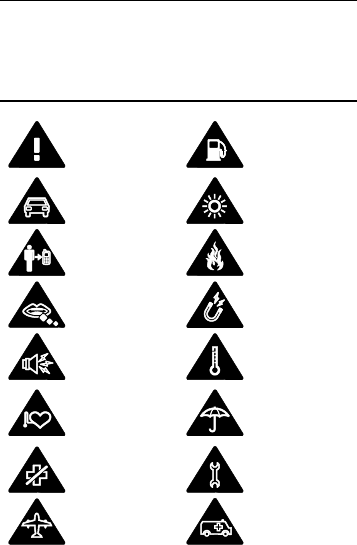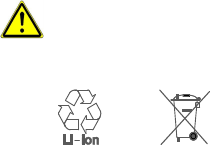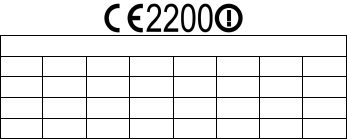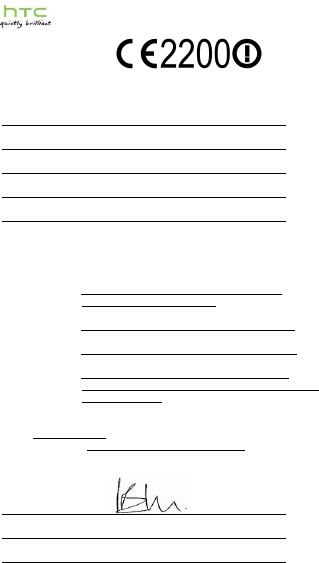Contents
- 1. User Manual
- 2. User Manual Safety Guide
- 3. User Manual Safety
User Manual Safety Guide

Safety and
regulatory guide

2 Safety and regulatory guide
Please read before proceeding
THE BATTERY IS NOT FU LLY CHAR GED W HEN YOU TAKE THE
DEVICE OUT O F THE BOX.
Privacy restrictions
Some countries require full disclosure of rec orded telephone
conversations.
Pictograms and graphic symbols
Read this manual’s
Safety Information
and General
Precautions.
Do not use while
re-fuelling
Do not use hand-held
while driving
This device may
produce a bright or
flashing light
For body-worn
operation maintain a
separation of 1.5 cm
Do not dispose of in a
fire
Small parts may
cause a choking
hazard
Avoid contact with
magnetic media
This device may
produce a loud sound
Avoid extreme
temperatures
Keep away from
pacemakers and
other personal
medical devices
Avoid contact with
liquid, keep dry
Switch off when
instructed in hospitals
and medical facilities
Do not try and
disassemble
Switch off when
instructed in aircraft
and airports
Do not rely on this
device for emergency
communications

Safety and regulatory guide 3
Switch off in explosive
environments
Only use approved
accessories
Important health information and safety precautions
When using this product, the safety precautions below must be taken to
avoid possible legal liabilities and dam ages.
Retain and follow all product safety and operating instructions. Observe all
warnings in the operating instructions on the prod uct.
To reduce the risk of bodily injury, electric shock, fire, and dam age to the
equipment, observe the following precautions.
Electrical safety
This product is intended for use when sup plied with pow er from the
design ated battery or power supply unit. Other us age may be dangerous
and will invalidate an y approval given to this product.
Safety precautions for proper grounding installation
CAUTION: Connecting to improperly groun ded equipm ent can result in an
electric shock to your device.
This product is equipped with a USB Cable for connecting with desktop or
notebook com puter. Be sure your com puter is properly grounded (earthed)
before connecting this product to the computer. The power supply cord of
a desktop or noteb ook com puter has an equipm ent -grounding conductor
and a grou nding plug. The plug must be plugged into an appropriate outlet
which is properly installed and grou nded in accordance with all local
codes and ordinanc es.
Safety precautions for power supply unit
Use the correct external power source
A prod uct should be operated only from the type of pow er source
indicated on the electrical rating s label. If you are not sure of the type of
pow er source required, cons ult your authorized service provider or local
pow er company. For a product that operates from battery power or
other sources, refer to the operating instructions that are included with
the product.
This product should be operated only wi th the following designated
pow er supply unit(s).
AC adapter:
HTC, Model TC P900-US, TC P900-EU, TC P900-UK, TC P900-AU
Handle battery packs carefully
This product contains a Lithium-ion polymer or Lithium-ion battery.

4 Safety and regulatory guide
There is a risk of fire and burns if the battery pack is handled improperly.
Do not attempt to open or service the battery pack. Do not disassemble,
crush, puncture, short external contacts or circuits, dispose of in fire or
water, or expo se a battery pack to tem peratures higher than 60˚C
(140˚F).
WAR NING: To reduce risk of fire or burns, do not
disassemble, crush, puncture, short external contacts,
expose to tem perature above 60° C
(140° F), or dispose of in fire or water. Recycle or dispose
of used batteries acc ording to the local regulations or
reference guide su pplied with your product.
Take extra precautions
Keep the device dry and aw ay from water or any liquid as it may
cause a short circuit.
The phone should only be connected to products that bear the
USB-IF logo or have com pleted the USB-IF complianc e program.
If the battery leaks:
Do not allow the leaking fluid to come in contact with skin or clothing.
If already in contact, flush the affected area immediately with clean
water and seek medical advice.
Do not allow the leaking fluid to come in contact with eyes. If already
in contact, DO NOT rub; rinse with clean water immediately and seek
medical advice.
Take extra precautions to keep a leaking battery away from fire as
there is a danger of ignition or explosion.

Safety and regulatory guide 5
Safety precautions for direct sunlight
Keep this product away from excessive moisture an d extreme
temperatures. Do not leav e the product inside a vehicle or in places w here
the temp erature may exceed 60°C (140° F), such as on a car dashboard,
window sill, or behind a glass that is exposed to direct sunlight or strong
ultraviolet light for extend ed periods of time. This may dam age the product,
overheat the battery, or pose a risk to the vehicle.
Prevention of hearing loss
CAUTION: Permanent hearing loss may occur if
e
arph ones or headphones are used at high volume
for prolonged periods of time.
This device and earphone have been tested to com ply with the Sound
Pressure Level requirement laid down in the applicable EN 50332-1
and/or EN 50332-2 standards.
Safety in aircraft
Due to the possible interference caus ed by this product to an aircraft’s
navigation system and its communications network, using this device’s
phone function on board an airplane is against the law in mo st countries. If
you want to use this device whe n on board an aircraft, rem em ber to turn
off your phon e by switching to Airplane M ode.
Environment restrictions
Do not use this product in gas stations, fuel depots, chemical plants or
where blasting operations are in progress, or in potentially explosive
atmospheres such as fuelling areas, fuel storehouses, below deck on
boats, chemical plants, fuel or che mical tran sfer or storage facilities, and
areas where the air contains chemicals or particles, such as grain, dust, or
metal powders. Please be aw are that sparks in suc h areas could cause an
explosion or fire res ulting in bodily injury or even death.
Explosive atmospheres
When in any area with a potentially explosive atmosphere or where
flammable materials exist, the product should be turned off and the user
should obey all sign s and instructions. Sparks in such areas could caus e
an explosion or fire resulting in bodily injury or even death. Users are
advised not to use the eq uipment at refueling points suc h as service or
gas stations, and are reminded of the need to observe restrictions on the
use of radio equipment in fuel depots, chemical plants, or where blasting
operations are in progress. Areas with a potentially explosive atmosphere
are often, but not always, clearly marked. These include fueling areas,
below deck on boats, fuel or chemical transfer or storage facilities, an d
6 Safety and regulatory guide
areas where the air contains chemicals or particles, such as grain, dust, or
metal pow ders.
Road safety
Full attention must be given to driving at all times in order to reduce the
risk of an accide nt. Using a pho ne while driving (even with a hands free kit)
causes distraction and can lead to an accident. You must comply with
local laws and regulations restricting the use of wireless devices while
driving.
Safety precautions for RF exposure
Avoid using your ph one near metal structures (for exam ple, the steel
frame of a building).
Avoid using your ph one near strong electrom agnetic sources, such as
microw ave ovens, sound speakers, TV and radio.
Use only original manufacturer-approved accessories, or acces sories
that do not contain any metal.
Use of non-original manufacturer-approved acces sories may violate
your local RF ex posure guideline s and should be avoided.
Interference with medical equipment functions
This product may cause medical equipment to malfunction. The use of
this device is forbidden in most hospitals and medical clinics.
If you use any other person al me dical device, co nsult the manufacturer of
your device to determine if they are ad equately shielded from extern al RF
energy. Your physician may be able to assist you in obtaining this
information.
Turn your phone OFF in health care facilities when any regulations posted
in thes e areas instruct you to do so. Hospitals or health care facilities may
be using equipment that could be sensitive to external RF en ergy.
Hearing aids
Some digital wireless phones may interfere with some he aring aids. In the
event of such interference, you may want to consult your service provider,
or call the customer service line to discuss alternatives.
Electrical safety
Accessories
Use only approv ed ac cessories.
Do not connect with incompatible products or acces sories.
Connection to a car
Seek professional advice when connecting a phone interface to the
vehicle electrical system.
Faulty and damaged products
Safety and regulatory guide 7
Do not atte mpt to disassemble the phone or its accessory.
Only qualified pers onnel must service or repair the phon e or its
accessory.
General precautions
You alone are responsible for how you use your phone and any
consequences of its use. You must always switch off your phone
wherever the use of a phone is prohibited. Use of your phone is subject to
safety meas ures designed to protect users and their environment.
Avoid applying exc essive pressure to the device
Do not apply excessive pressure on the screen a nd the device to
prevent damaging them and rem ov e the device from your pants’ pocket
before sitting down. It is also recomm ended that you store the device in
a protective case and only use the device stylus or your finger when
interacting with the touch screen. Cracked display screens due to
improper handling are not covered by the warranty.
Protect your phone
Always treat your phone and its accessories with care and keep them
in a clean and dust-free place.
Do not expose your phon e or its accessories to open flames or lit
tobacc o products.
Do not drop, throw or try to bend your phone or its accessories.
Do not use harsh chemicals, cleaning solvents, or aeros ols to clean
the device or its accessories.
Do not paint your phone or its access ories.
Do not attempt to disassemble your phone or its accessories, only
authorised personnel must do so.
Store your phone or its accessories at temperatures between 0° C to
40° C.
Please check local regulations for disposal of electronic products.
Do not carry your phone in your back pocket as it could break when
you sit dow n.
Damage requiring service
Unplug the product from the electrical outlet and refer servicing to an
authorized service technician or provider under the following conditions:
The product has been expose d to rain or liquid, dropped, subject to
impact or dam aged.
There are noticeable signs of overheating.
The product does not operate norm ally when you follow the operating
instructions.
Avoid hot areas
The product should be placed aw ay from heat sources such as
radiators, heat registers, stoves, or other products (including amplifiers)
8 Safety and regulatory guide
that produce heat.
Avoid wet areas
Never use the product in rain, or near washbasins or other wet or high
humidity locations. If your product gets wet, do not try to dry the product
with the us e of an ov en or dryer, as this may damage your product.
Avoid using your de vice after a dramatic change in tem perature
When you move your device between environments with very different
temperature and/or humidity ranges, condensation m ay form on or
within the device. To avoid da maging the d evice, allow sufficient time
for the moisture to evaporate before using the device.
NOTICE: When taking the device from low-temperature conditions into
a warmer environment or from high-temperature conditions into a
cooler environment, allow the device to acclimate to room temperature
before turning on power.
Avoid pushing objects into product
Never push objects of any kind into cabinet slots or other openings in
the product. Slots and ope nings are provided for ventilation. These
openings m ust not be blocked or covered.
Adjust the volume
Turn down the volume b efore using headphones or other audio
devices.
Cleaning
Unplug the product from the wall outlet before clea ning. Do not use
liquid cleaners or aeros ol cleaners. Use a dam p cloth for cleaning, but
NEVER use water to clean the LCD screen.
Small children
Do not leave your ph one and its acces sories within the reach of small
children or allow them to play with it. They could hurt them selves or
others, or could accidentally damage the phone. Your phone contains
small parts with sharp edges that may cause an injury or which could
become detac hed and create a choking haz ard. Consult the doctor
immediately if the access ories or battery are swallowed.
Repetitive motion injuries
To minimise the risk of RSI, when Texting or playing gam es with your
phone:
Do not grip the phone too tightly
Press the buttons lightly
Electrostatic discharge (ESD)
Do not touch the SIM card’s metal connectors.
Emergency calls
This phone, like any wireless phone, operates using radio signals,
which cannot guarantee connection in all condition s. Therefore, you

Safety and regulatory guide 9
must never rely solely on any wireless phone for emergency
com munications.
Regulatory agency identifications
For regulatory ide ntification purposes, your product is assigne d a model
number of 0PKV100.
FCC ID: NM 80PKV 100
To ensure continued reliable and safe operation of your device, use only
the access ories listed below with your 0PKV100.
The Battery Pack has been assigned a model number of B0PGE 100.
NOTE: This product is intended for use with a certified Class 2 Limited
Power Source, rated 5 Volts DC, maximum 1.5 Amp power supply unit.
European Union notice
Products with CE marking comply with the R&TTE Directive (19 99/5/EC),
the EMC Directive (2004/108/EC), and the Low Voltage Directive
(2006/95/EC) issued by the Co m mission of the European Community.
Compliance with these directives implies conformity to the following
European Nor ms (in parentheses are the equivalent international
standard s).
EN 5036 0
EN 5056 6
EN 6247 9
EN 6220 9-1
EN 6220 9-2
EN 6095 0-1
EN 301 489-1
EN 301 489-3
EN 301 489-7
EN 301 489-17
EN 301 489-24
EN 300 328
EN 301 893
EN 300 440-1
EN 300 440-2
EN 301 908-1
EN 301 908-2
EN 301 908-13
EN 301 511
EN 302 291-1
EN 302 291-2

10 Safety and regulatory guide
This equipment may be operated in:
AT BE BG CH CY CZ DE DK
EE ES FI FR GB GR HU IE
IT IS LI LT LU LV MT NL
NO PL PT RO SE SI SK TR
Federal Communications Commission notice
This device com plies with part 15 of the FCC Rules. Operation is subject
to the following two conditions: (1) This device may not cause harmful
interference, and (2) this device must accept any interference received,
including interference that may cause undesired operation.
This equipment has been tested and found to comply with the limits for a
Class B digital device, pursuant to Part 15 of the FCC Rules. These limits
are designed to provide reasonable protection against harmful
interference in a residential installation. This equipment generates, uses,
and can radiate radio frequency energy and, if not installed and used in
accordance with the instructions, may cause harmful interference to radio
com munications. However, there is no guarantee that interference will not
occur in a particular installation. If this equipment does cause har mful
interference to radio or TV reception, which can be determined by turning
the equipment on and off, the user is encouraged to try to correct the
interference by one or more of the following m easures:
Reorient or relocate the receiving antenna.
Increase the separation between the equipment and rec eiver.
Connect the eq uipment into an outlet on a circuit different from that to
which the receiver is connected.
Consult the dealer or an experienced radio or television technician for
help.
Modifications
The FCC requires the user to be notified that any changes or
modifications made to the device that are not expressly approved by HTC
Corporation m ay void the user’s authority to operate the equipment.
FCC RF Radiation Exposure Statement
This Transmitter has been demonstrated co-location complianc e
requirements with Bluetooth and WLA N.
This tran smitter must not be co-locate d or operating in conjunction with
any other antenna or transmitter.

Safety and regulatory guide 11
This equipment complies with FCC RF radiation exposure limits set
forth for an uncontrolled environ m ent.
Exposure to Radio Frequency Energy
Your wireless device has an internal antenna that emits radio freq uency
(RF) energy. Human exposure to RF energy has been and continues to
be the subject of scientific research. According to the U.S. Food and Drug
Administration (FDA), “the weight of scientific evidence has not linked cell
phones with any health problem s.” You can acc ess this FDA publication
and other information on huma n exposure to RF energy at:
U.S. Food an d Drug Administration:
http://www.fda.gov/Radiation-EmittingProducts/RadiationEmittingProductsandPr
ocedures/HomeBusinessandEntertainment/CellPhones/ucm116282.htm
Federal Com munications Co mmission:
http://www.fcc.gov/encyclopedia/radio-frequency-safety
NIH National Institute of Environmental Health Sciences:
http://www.niehs.nih.gov/health/topics/agents/cellphones/
World Health Orga nization:
http://www.who.int/mediacentre/factsheets/fs193/en/
IEEE Committee on Man and Radiation:
http://ewh.ieee.org/soc/embs/comar/
International Commission on Non-Ionizing Radiation Protection:
http://www.icnirp.de/
Specific Absorption Rate (SAR) Testing
Your device has been designed to comply with applicable limits for RF
exposure. These limits use a unit of measurement called Specific
Absorption Rate, or SAR, which refers to the rate at which the body
absorbs RF energy. The Federal Communications Commission (FCC)
has establish ed a SAR limit for mobile phones of 1.6 W/kg, which applies
in the United States and other countries that follow the FCC’s SAR limit.
This limit is base d upon standards dev eloped by expert non-government
organizations, such as the Institute of Electrical and Electronics Engineers
(IEEE) and the National Council on Radiation Protection an d
Measure m ents (NCRP), and input from other federal agen cies such as
the FDA and EPA. In countries that follow the Council of the European
Union, the SAR limit is 2.0 W/kg.
SAR testing is conducted with the device placed in common operating
positions (e.g., held against the head, worn on the body) and transmitting
at its highest certified power level in eac h frequency band of op eration.
Because the device is transmitting at its high est certified power level, SAR
tests capture a worst-case operating scenario and therefore often do not
reflect the amount of RF exposure during normal, everyday use. More
information on SAR testing is available on the FCC’s website at

12 Safety and regulatory guide
http://www.fcc.gov/guides/wireless-devices-and-health-concerns
.
HTC Corp. submitted SAR test results demonstrating compliance with the
FCC’s SAR limit for wireless devices as part of the FCC’s equipment
certification proc ess for this de vice. These results can be accessed via the
FCC’s equipm ent authorization database (found at
http://transition.fcc.gov/oet/ea/fccid/) by searching for the device’s FCC ID:
NM80PKV100
.This device’s maximum SAR values as reported to the
FCC are:
Safety and regulatory guide 13
SAR information
Head: 0.453 W/kg@10g (CE), 0.724 W/kg@1g (FC C)
Body: 0.237 W/kg@ 10g (CE), 0.367 W/kg @ 1g (FCC)
Body-worn O peration
This device was tested for typical bo dy-worn operations. A minimum
separation distance must be m aintained b etween the us er’s body and the
handset, including the antenna:
1.5 cm to com ply with the RF exposure req uirements in Europe
1 cm to comply with the RF expos ure requirements in the U.S.
Third-party belt-clips, holsters, and similar accessories used by this
device should not contain any metallic components. Body-worn
accessories that do not meet these requirements may not co mply with RF
exposure requirements and should be avoided.
Use only the supplied or an approv ed antenn a. Unauthorized antennas,
modifications, or attachments could impair call quality, damage the phone,
or result in violation of regulations. Do not use the phone with a dam aged
antenna. If a damaged antenna comes into contact with the skin, a minor
burn may res ult. Please contact your local dealer for replacement
antenna.
Telecommunications & Internet Association (TIA) safety
information
Pacemakers
The Health Industry Manufacturers Association recom mends that a
minimum se paration of 15 cm (6 inches) be maintained between a
handheld wireless phone and a pacemaker to avoid potential interference
with the pacem aker. These reco mmendations are consistent with the
independent research by and recom mendations of Wireless Technology
Research.
Persons with pacemakers:
Should ALWAYS keep the phone more than 15 cm (6 inches) from their
pacemaker when the phone is turned ON.
Should not carry the phone in a breast pocket.
Should use the ear opposite the pacem aker to minimize the potential
for interference. If you hav e any reason to sus pect that interference is
taking place, turn the phone O FF immediately.

14 Safety and regulatory guide
WEEE notice
The Directive on Waste Electrical and Electronic Equipment (WEEE),
which entered into force as E uropean law on 13th February 2003, resulted
in a major change in the treatment of electrical equipment at end-of-life.
The purpose of this Directive is, as a first priority, the prev ention of WEEE,
and in addition, to promote the reuse, recycling and other forms of
recovery of suc h wastes so as to reduce disposal.
The WEEE logo (show n at the left) on the product or on its
box indicates that this product must not be disposed of or
dumped with your other household waste. You are liable to
dispose of all your electronic or electrical waste equipment
by relocating over to the specified collection point for
recycling of such h azardous waste. Isolated collection and
proper recovery of your electronic and electrical waste
equipment at the time of disposal will allow us to help
conserving natural resources. Moreover, proper recycling of
the electronic and electrical waste equipment will ensure
safety of human health and environment. For more
information ab out electronic and electrical waste equipment
disposal, recovery, and collection points, please contact
your local city center, household waste dispos al service,
shop from where yo u purchas ed the equipment, or
manufacturer of the equipment.
RoHS compliance
This product is in compliance with Directive 2011/65/EU of the European
Parliam ent and of the Council of 8 June 2011, on the restriction of the use
of certain hazardous substances in electrical and electronic equipment
(RoHS) and its ame ndm ents.

DECLARATION OF CONFORMITY
Intended for use in EU
For the following equipment:
Smartphone
(Product Description)
HTC One M8s
(Product Marketing Name)
0PKV100
(Product Name)
HTC Corporation
(Manufacturer Name)
No.23, Xinghua Rd., Taoyuan City, Taoyuan County 330, Taiwan.
(Manufacturer Address)
is herewith confirmed to comply with the essential requirements of Article 3 of the R&TTE 1999/5/EC Directive,
if used for its intended use and that the following standards has been applied:
1. Health (Article 3.1.a of the R&TTE Directive)
Applied standard(s): EN 50360:2001/A1:2012, EN 62209-1:2006, EN 62209-2:2010,
EN 62479:2010, EN 50566:2013/AC:2014
2. Safety (Article 3.1.a of the R&TTE Directive)
Applied standard(s): EN 60950-1: 2006 + A11: 2009 + A1: 2010 + A12: 2011 + A2: 2013
3. Electromagnetic compatibility (Article 3.1.b of th e R&TTE Directive)
Applied standard(s): EN 301 489-1 V1.9.2 / -3 V1.6.1 / -7 V1.3.1 / -17 V2.2.1 / -24 V1.5.1
4. Efficient use of the radio frequency spectru m (Article 3.2 of the R&TTE Directive)
Applied standard(s): EN 301 511 V9.0.2 / EN 301 908-1 V6.2.1 / -2 V6.2.1 / -13 V6.2.1
EN 300 328 V1.8.1 / EN 301 893 V1.7.1 / EN 300 440-1 V1.6.1 / -2 V1.4.1
EN 302 291-1 / -2 V1.1.1
Additional Compliance:
Energy: Regulation 278/2009
Restricted Substances: EN 50581:2012, RoHS Directive 2011/65/EU
Person responsible for making this declaration:
Philip Blair
(Name and signature)
Product Director
(Position / Title)
United Kingdom 2015/03/10
(Place) (Date)
宏達國際電子股份有限公司
HTC Corporation
23, Xinghua Rd.,
Taoyuan 330, Taiwan

16 Safety and regulatory guide
91HXXXXX-XXM Rev.A
htc.com